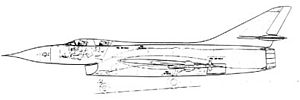- Hawker P.1103
-
P.1103 Role Interceptor National origin United Kingdom Manufacturer Hawker Aircraft Status Design only Number built None The Hawker P.1103 was a design by Hawker Aircraft to meet the British Operational Requirement F.155; it was not developed into an aircraft.
Contents
Background
Operational Requirement F.155 was a Operational Requirement issued by the British Ministry of Supply in 1955 for an interceptor aircraft to defend the United Kingdom from high flying supersonic bombers.
F.155 specified exacting demands:
- The capability of making an intercept within 20 minutes of target contact (250 miles from the UK) with a target speed of Mach 1+
- Ceiling: 60,000 ft (18,000 m)
- Armament: a mixture of infra-red guided missiles and radar guided missiles
- Crew: A crew of two was specified because of the anticipated workload: pilot plus weapons systems operator (WSO)/navigator
The Ministry of Supply made clear in the requirement that the plane and missiles should be treated as a "weapon system" i.e., a cohesive whole. The armament specifications were covered by a separate Operational Requirement, OR.1131, which listed two missile systems: the infra-red guided de Havilland "Blue Vesta" and the radar-guided Vickers "Red Hebe".
Hawker P1103
The submission by Hawker Siddeley a design by the legendary designer Sir Sydney Camm was effectively a supersonic development of his successful Hawker Hunter design, using a single engine - a 25,000 lb development of the de Havilland Gyron breathing through an under-chin air intake. Two detachable rocket boosters, to give a 3.7 minute boost, were carried in midwing nacelles.
1957 Defence White Paper
Although a nuclear threat from high-flying Soviet supersonic nuclear-armed bombers was identified in 1955, F.155 calling for supersonic interceptors (in service by 1962) was superseded by the 1957 Defence White Paper. The paper was a major review of military spending and one of its elements was the cancellation of nearly all manned fighter projects as a radical change had occurred in strategic threats with the expectation that intercontinental ballistic missiles and low-level strike would replace high flying bombers.
See also
- Hawker P.1121
Notes and references
- Notes
- Bibliography
- Buttler, Tony. British Secret Projects: Jet Fighters Since 1950. Leicester, UK: Midland Publishing, 2000, ISBN 1-85780-095-8.
Hawker and Hawker Siddeley aircraft By project number P.1000 · P.1001 · P.1002 · P.1003 · P.1004 · P.1005 · P.1006 · P.1007 · P.1008 · P.1009 · P.1010 · P.1011 · P.1012 · P.1013 · P.1014 · P.1015 · P.1016 · P.1017 · P.1018 · P.1019 · P.1020 · P.1021 · P.1022 · P.1023 · P.1024 · P.1025 · P.1027 · P.1028 · P.1029 · P.1030 · P.1031 · P.1032 · P.1033 · P.1034 · P.1035 · P.1036 · P.1037 · P.1038 · P.1039 · P.1040 · P.1041 · P.1042 · P.1043 · P.1044 · P.1045 · P.1046 · P.1047 · P.1048 · P.1049 · P.1050 · P.1051 · P.1052 · P.1053 · P.1054 · P.1055 · P.1056 · P.1057 · P.1058 · P.1059 · P.1060 · P.1061 · P.1062 · P.1063 · P.1064 · P.1065 · P.1067 · P.1068 · P.1069 · P.1070 · P.1071 · P.1072 · P.1073 · P.1074 · P.1075 · P.1076 · P.1077 · P.1078 · P.1079 · P.1080 · P.1081 · P.1082 · P.1083 · P.1084 · P.1085 · P.1087 · P.1088 · P.1089 · P.1090 · P.1091 · P.1092 · P.1093 · P.1094 · P.1095 · P.1096 · P.1097 · P.1098 · P.1099 · P.1100 · P.1101 · P.1102 · P.1103 · P.1104 · P.1105 · P.1106 · P.1107 · P.1108 · P.1109 · P.1114 · P.1115 · P.1116 · P.1118 · P.1120 · P.1121 · P.1122 · P.1123 · P.1124 · P.1125 · P.1126 · P.1127 · P.1128 · P.1129 · P.1130 · P.1131 · P.1132 · P.1134 · P.1136 · P.1137 · P.1139 · P.1140 · P.1141 · P.1143 · P.1149 · P.1150 · P.1152 · P.1154 · P.1155
P.V.3 · P.V.4By name Audax · P.1081 ("Australian") · Cygnet · Danecock · Demon · Duiker · Fury · Hardy · Harrier · Hart · Hawfinch · Hector · Hedgehog · Henley · Heron · Hind · Hoopoe · Hornbill · Hornet · Horsley · Hotspur · Hunter (variants) · Hurricane (variants) · Kestrel · Nimrod · Osprey · Sea Fury · Sea Hawk · Tempest · Tomtit · Tornado · Typhoon · Woodcock
Hawker Siddeley Lists relating to aviation General Aircraft (manufacturers) · Aircraft engines (manufacturers) · Airlines (defunct) · Airports · Civil authorities · Museums · Registration prefixes · Rotorcraft (manufacturers) · TimelineMilitary Accidents/incidents Records Categories:- Abandoned military aircraft projects of the United Kingdom
Wikimedia Foundation. 2010.

